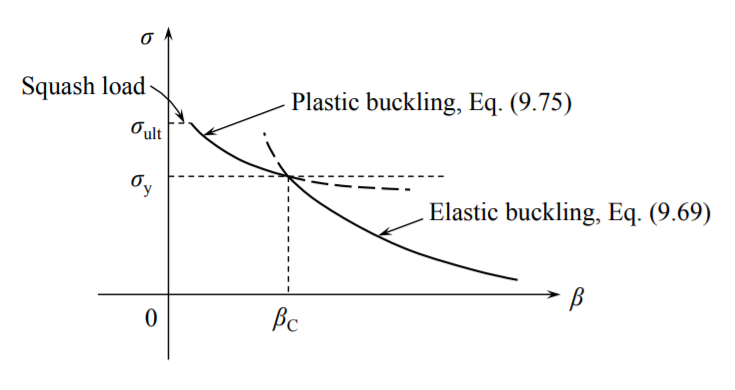8.6: Plastic Buckling of Columns
- Page ID
- 21523
Let’s consider the pin-pin column for which the critical buckling load is
\[P_c = \frac{\pi^2 EI}{l^2}\]
The corresponding critical buckling stress \(\sigma_c\) is
\[\sigma_c = \frac{P_c}{A} = \frac{\pi^2 E}{l^2} \frac{I}{A} \label{9.69}\]
where \(A\) is the cross-sectional area. Note that the stress is calculated over the pre-buckling, primary equilibrium path, for which there is no bending. Denoting by \(\rho\) the radius of gyration, \(A \rho^2 \equiv I\), Equation \ref{9.69} can be re-written in terms of the slenderness ratio \(\beta = l/\rho\)
\[\sigma_c = \pi^2 E \frac{1}{\beta^2} \label{9.70}\]
The buckling stress is small for long, slender column and is rapidly increasing for short columns. At some critical column length, the yield stress of the material \(\sigma_y\) will be reached, Figure (\(\PageIndex{1}\)).

The critical slenderness ratio at which the buckling stress reaches the yield stress of the material is obtained from Equation \ref{9.70} by setting \(\sigma_c = \sigma_y\)
\[\beta_c = \frac{l_c}{\rho} = \pi \sqrt{\frac{E}{\sigma_y}} \]
To give you the feel of the critical slenderness, consider a mild steel column with \(E = 210\) GPa, \(\sigma_y = 250\) MPa and square cross-section \(A = h^2\), for which the radius of gyration is \(\rho^2 = h^2/12\)
\[\left( \frac{l}{h} \right)_c = \pi \sqrt{\frac{E}{\sigma_y}} \cdot \frac{1}{2 \sqrt{3}} \approx 30 \]
Columns more slender than the critical will buckle elastically before yielding (path AB). Shorter column or stocky column will yield before buckling. What will happen with such columns? They will deform plastically in axial compression and eventually buckle in the plastic range.
Gerrard (1948) extended the predictive capability of Equation \ref{9.70} into the plastic range by replacing the elastic modulus by the tangent modulus \(E_t = \frac{d\sigma}{d\epsilon}\)
\[(\sigma_c)_{\text{plastic}} = \pi^2 E_t \frac{1}{\beta^2}, \text{ for } \beta < \beta_c \label{9.73}\]
For example, for a plastic material obeying the power hardening rule,
\[\sigma = B \cdot \epsilon^n \label{9.74a}\]
\[\frac{d\sigma}{d\epsilon} = nB\epsilon^{n−1} \label{9.74b}\]
Substituting Equation \ref{9.74a} - \ref{9.74b} into Equation \ref{9.73}, the critical buckling strain \(\epsilon_c\) is
\[\epsilon_c = \frac{\pi^2 n}{\beta^2} \]
Using the hardening rule, the buckling stress is
\[\sigma_c = B \left[ \frac{\pi^2 n}{\beta^2}\right]^n \]
In the above equation \(B\) is the amplitude of the hardening law and \(n\) is the hardening exponent. For most structural steels \(n \approx 0.1-0.2\).

Very short columns are beyond the scope of the elementary theory of thin and slender beams. They will never buckle but flatten as a pancake.


